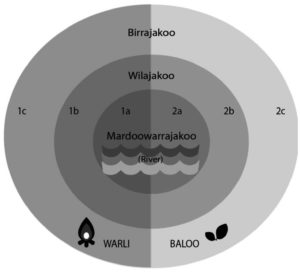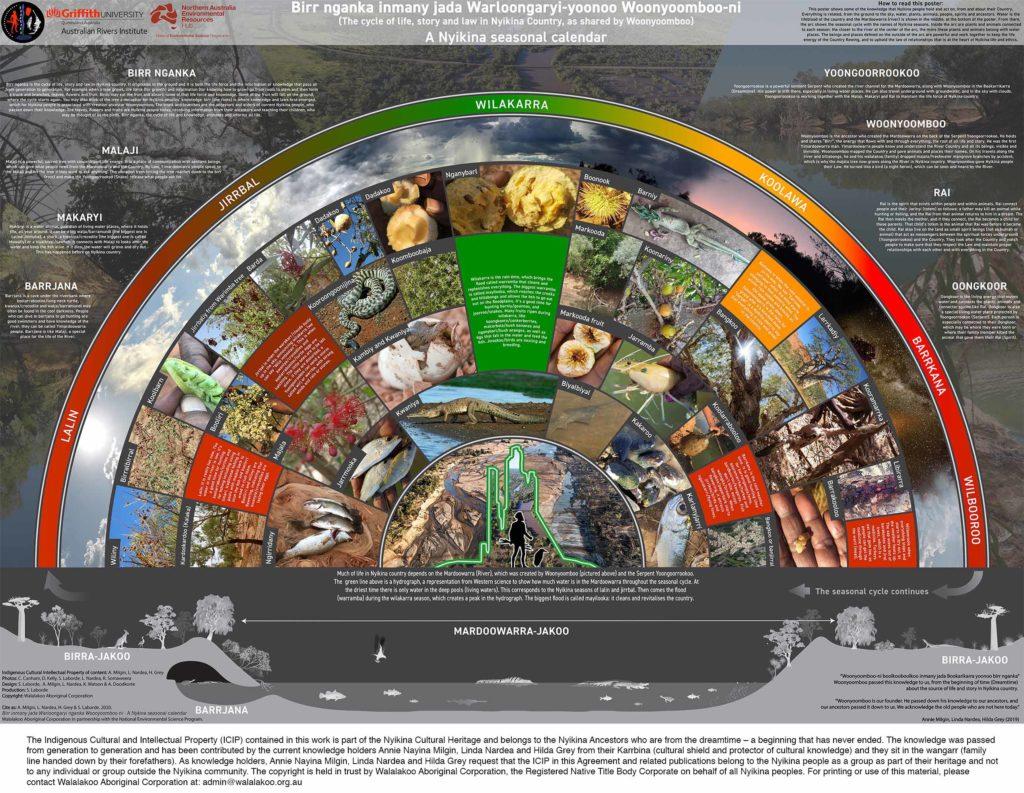9 October 2020

A simplified Nyikina hydro‐ecological framework. The hydrograph at the centre represents an annual cycle of river flows; the arc around it represents the seasonal cycle and the profile below it illustrates some of the different habitats of Nyikina Country (expressed in Nyikina in terms of ‘belonging’). The vignettes (a) and (b) are examples of hydro‐ecological food chains in Nyikina Country, placed in the framework in relation to corresponding seasons (Wilakarra‐Koolawa for (a) and Willbooroo for (b)), and habitats (Mardoowarrajakoo for (a) and Birrajakoo for (b)). (a) River figs ripen after the floods, feeding fish and people. (b) Medicinal gumtree sap oozes out when the hot weather starts, turkeys feed on the sap and people hunt turkeys as their meat is particularly healthy at that time. People and Nature, First published: 05 October 2020, DOI: (10.1002/pan3.10149).
Maintaining mutually supportive relationships with places and non-human beings is a foundation of sustainability for Nyikina people. The river, for example, needs human connection and care to sustain its health, just like a person does. Although quantitative indicators of ecosystem health are important, simply meeting volumetric targets for water flows or fish numbers is not enough to ensure the river’s vitality. This can only be achieved by maintaining reciprocal relationships between the river, its waters, plants and animals, people and ancestral beings.

Nyikina language framework for connecting plant (Baloo in Nyikina) and animal life (Warli translates as ‘meat’ or ‘edible animals’), and habitat, in terms of degrees of belonging to the river and water: (1a) edible animals who live in or by the river; (1b) edible animals from aquatic habitats more broadly; (1c) edible animals found anywhere in Nyikina Country; (2a) algae and riparian plants found by the river; (2b) plants growing near water bodies in general; (2c) plants found anywhere in Nyikina Country. People and Nature, First published: 05 October 2020, DOI: (10.1002/pan3.10149).
The water-planning framework should be based upon this critical set of relationships. The researchers encourage sustainability scientists and water planners to work collaboratively with Indigenous people so that custodial relationships under Indigenous law are given equal consideration with hydro-ecological science and federal and state legislative requirements.
This collaboration has also resulted in the beautiful Nyikina Seasonal Calendar, a cultural poster about the cycle of life, story and law in Nyikina Country. The calendar was launched at an event on Nyikina Country in Derby, Western Australia, on 15 November.

The Nyikina Seasonal Calendar.

Venn diagram showing some of the relationships between beings that are known by Nyikina experts to be essential to the sustainability of Nyikina Country. Yoongoorrookoo are cosmological creation beings linked with water and light. People (Ngarrangoonil) are connected to animals and plants (Warli and Baloo) through totems (jarinyi). Rai are spirit beings that act as messengers between Yoongoorrookoo and the Country, including people. Malaji and Makaryi are plant and animal guardians that care for parts of the Country, in relation with Yoongoorrookoo. In the middle, linking all beings, is the cycle of life (Birr Nganka) and the living energy that moves water (Oongkoor). These dynamic connections are part of the Law of relationships (Warloongaryi) that maintains the vitality of the Country (Birra). People and Nature, First published: 05 October 2020, DOI: (10.1002/pan3.10149).
Want to know more about the Resilient Landscapes Hub's activities and our research into practical solutions to environmental problems? Stay informed about activities, research, publications, events and more through the Hub newsletter.
"*" indicates required fields